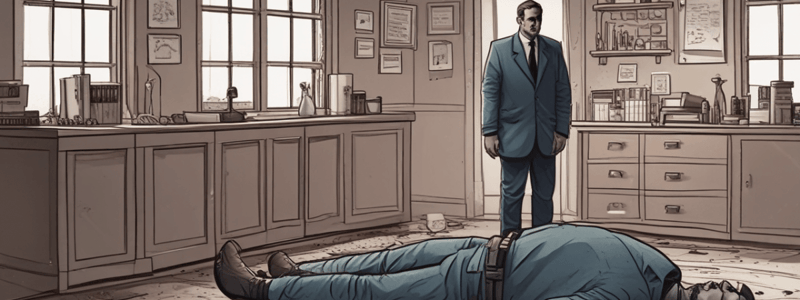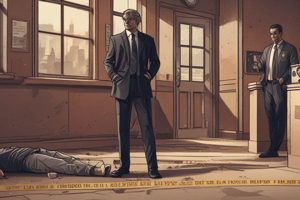Podcast
Questions and Answers
What is the primary objective of a criminal investigation?
What is the primary objective of a criminal investigation?
- To identify statutes pertaining to arson and explosives
- To identify the role of the patrol officer
- To list the basic types of bombs
- To achieve justice and reveal the truth (correct)
What type of bomb is designed to produce a burning effect?
What type of bomb is designed to produce a burning effect?
- Explosive bomb
- Incendiary bomb (correct)
- Reckless burning bomb
- Class A felony bomb
What is not considered arson?
What is not considered arson?
- Destroying a building for a lawful reason with permission (correct)
- Explosive damage to a property
- Knowingly damaging a building by starting a fire
- Reckless burning of a facility
Who should conduct a search of a facility for a device after a bomb threat?
Who should conduct a search of a facility for a device after a bomb threat?
What type of felony is knowingly damaging a building or inhabitable structure by starting a fire or causing an explosion?
What type of felony is knowingly damaging a building or inhabitable structure by starting a fire or causing an explosion?
What is the charge for knowingly damaging property of another by starting a fire or causing an explosion?
What is the charge for knowingly damaging property of another by starting a fire or causing an explosion?
What is the definition of oxidation in the context of combustion?
What is the definition of oxidation in the context of combustion?
What is the primary requirement for an oxidation reaction to occur?
What is the primary requirement for an oxidation reaction to occur?
How is heat typically transferred in structural fires?
How is heat typically transferred in structural fires?
What is the characteristic of the First Phase (incipient) of a structural fire?
What is the characteristic of the First Phase (incipient) of a structural fire?
What is a potential hazard during the Third Phase (Smoldering) of a structural fire?
What is a potential hazard during the Third Phase (Smoldering) of a structural fire?
What is the typical ceiling temperature during the Second Phase (free burning/flame producing) of a structural fire?
What is the typical ceiling temperature during the Second Phase (free burning/flame producing) of a structural fire?
What is the minimum number of people that must be seriously physically injured for it to be considered a Class 'A' Felony?
What is the minimum number of people that must be seriously physically injured for it to be considered a Class 'A' Felony?
What is the classification of the crime of knowingly possessing, manufacturing, transporting, repairing, or selling an explosive?
What is the classification of the crime of knowingly possessing, manufacturing, transporting, repairing, or selling an explosive?
Who should conduct a building search after a bomb threat?
Who should conduct a building search after a bomb threat?
What is the general rule for securing a perimeter at a bombing scene with an unknown sized device?
What is the general rule for securing a perimeter at a bombing scene with an unknown sized device?
What is the purpose of limiting admittance to a bombing scene?
What is the purpose of limiting admittance to a bombing scene?
What is the minimum number of buildings that must be substantially damaged for it to be considered a Class 'A' Felony?
What is the minimum number of buildings that must be substantially damaged for it to be considered a Class 'A' Felony?
What is the classification of the crime of making a false bomb report?
What is the classification of the crime of making a false bomb report?
What is the purpose of having all personnel enter and leave a bombing scene by the same path?
What is the purpose of having all personnel enter and leave a bombing scene by the same path?
What is the minimum weight of a device that can affect two adjoining rooms on all sides, including up and down?
What is the minimum weight of a device that can affect two adjoining rooms on all sides, including up and down?
What is the fourth element required for a fire to burn?
What is the fourth element required for a fire to burn?
Study Notes
Introduction to Criminal Investigation
- The objective of a criminal investigation is to gather evidence and identify the perpetrator of a crime
- A procedure for conducting an investigation will be discussed, including the main objectives and steps taken in a preliminary investigation
Types of Bombs
- Explosive Bomb: causes damage by fragmentation, heat, and blast wave
- Incendiary Bomb: constructed with flammable materials designed to produce a burning effect
Laws Pertaining to Arson and Explosives
- Arson (Class A, B, or C Felony): knowingly damaging a building or inhabitable structure by starting a fire or causing an explosion
- Knowingly burning or exploding (Class "D" Felony): knowingly damaging property of another by starting a fire or causing an explosion
- Reckless burning or exploding (Class "A" Misdemeanor): recklessly damaging or destroying a building or inhabitable structure of another by knowingly starting a fire or causing an explosion
- Negligent burning or exploding (Class "B" Misdemeanor): with criminal negligence causing damage to property of another by fire or explosion
- Causing catastrophe (Class "A" Felony): knowingly causing death or serious physical injury to ten or more people; or substantial damage to five or more buildings or inhabitable structures
- Possession, manufacture, transport, repair, or sale of certain weapons prohibited (Class "C" Felony)
- Bombing and other explosive matter upon bus or near bus terminal (Class "A" Felony)
- False Bomb Report (Class "A" Misdemeanor): knowingly making or causing to be made a false report to any person that a bomb or other explosive has been placed in a public or private place or vehicle
Bomb Threat Response Procedures
- Turn radio off when nearing the scene to avoid detonating an explosive device
- Contact the manager or person in charge of the building
- Building search should be conducted by personnel familiar with the premises, with police assistance if necessary
- Evacuation procedures:
- Evacuate everyone if an explosive device or suspected device is found
- Be aware of the possibility of a second device
- Post guards at entrances
- Evacuation distances depend on the size of the explosive device:
- Small device (up to 5 lbs.): up to the size of a shoe box or lunch box
- Medium device (up to 10 lbs.): small attaché case/large handbag
- Large device (up to 50 lbs.): large suitcase
- Unknown sized device: secure perimeter of 300 feet
Bombing Scene Procedures
- Establish a perimeter by locating the furthest piece of debris from the blast seat
- Limit admittance to the scene to authorized personnel
- Use one entry/exit path to minimize the chance of destroying fragile evidence
- Be cautious of secondary devices while securing the perimeter
Elementary Chemistry of Fire
- Four elements of fire: heat, oxygen, fuel, and uninhibited chain reaction
- Heat is transferred in three ways: conduction, convection, and radiation
- Phases of structural fires:
- First Phase (incipient): fire produces gases, rapid progress after flaming starts
- Second Phase (free burning/flame producing): major involvement, convection heating
- Third Phase (Smoldering): burning is reduced to glowing embers, toxic/flammable gases present
Studying That Suits You
Use AI to generate personalized quizzes and flashcards to suit your learning preferences.
Description
Explore the primary objectives and procedures of a criminal investigation, including the main objectives and steps of a preliminary investigation.




